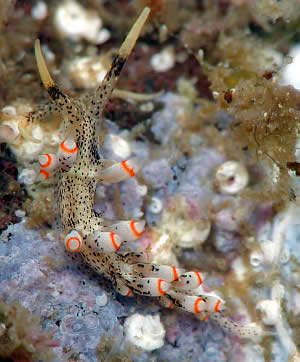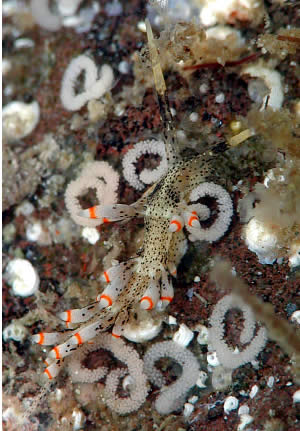
Herviella affinis
Baba, 1960
Order: NUDIBRANCHIA
Suborder: AEOLIDINA
Family: Glaucidae
DISTRIBUTION
Known only from Japan.
PHOTO
Manazuru-coast Sagami Bay, Japan, Size approx 10mm, Depth: 0.3m (Intertidal), 10 Aug 2002. Photo: Jun Imamoto
Herviella, is a genus of about ten or so small species usually with black specks and a gold or orange band below the ceratal tip. The cerata are arranged in a series of sloping single rows down each side of the body. H. affinis is characterised by the colour of the rhinophores - black speckling on the lower half, a black median band, and a yellow upper half. Baba (1960) described the yellow as 'chrome yellow' which would suggest an opaque bright yellow. However the photos posted here fit Baba's description except for the yellow on the rhinophores which in this case is a translucent yellowish tinge rather than an opaque pigment. A species from east Africa, Herviella cloaca differs mainly in having a white upper half to the rhinophores.
References:
• Baba, K (1960): The genus Herviella and a new species, H. affinis, from Japan (Nudibranchia - Eolidacea). Publications of the Seto Marine Biological Laboratory 8(2, December), 303-305.
• Baba, K (1966): Record of Herviella albida n. sp. from Seto, Kii, Japan (Nudibranchia - Eolidoidea). Publications of the Seto Marine Biological Laboratory 13(5, February), 361-363,Pl.15.
• Baba, K (1966): The anatomy of Herviella yatsui (Baba, 1930) and H. affinis Baba, 1960 (Nudibranchia - Eolidoidea). Publications of the Seto Marine Biological Laboratory 14(April), 1-6,Pls.1-2.
• Burn, R F (1963): Descriptions of Australian Eolidacea Mollusca: Opisthobranchia). 1. The genera Catriona and Herviella. Journal of the Malacological Society of Australia, 7(6 December), pp.12-pp.20.
• Burn, R F (1967): Revision of the genus Herviella (Opisthobranchia: Eolidacea). Malacologia 6(1-2), 223-230.
• Marcus, Er; Burch,JB (1965): Marine euthyneuran Gastropoda from Eniwetok Atoll, western Pacific. Malacologia 3(2), 235-262.
• Rudman, W.B. (1980) Aeolid opisthobranch molluscs (Glaucidae) from the Indian Ocean and the south-west Pacific. Zoological Journal of the Linnean Society, 68(2):139-172.
Rudman, W.B., 2002 (September 11) Herviella affinis Baba, 1960. [In] Sea Slug Forum. Australian Museum, Sydney. Available from http://www.seaslugforum.net/find/hervaffi
Related messages
Herviella affinis from Japan.
September 16, 2002
From: Jun Imamoto

Dear Bill.
I found this sea slug in a tide pool under a rock. It is the first time I have seen it and I think it was the egg masses that drew my attention to the slug. Ms. Yamada and I think it is Herviella affinis Baba, 1960. I feel this slug prefers the intertidal areas, or perhaps its food live intertidally. I am happy if these reports are useful for your research.
Manazuru-coast, Sagami Bay, Japan. Size approx 10mm, Intertidal, Temp: 25C. 10 Aug 2002.
Best Regards,
Jun Imamoto
http://umiushi.zive.net/
imamoto@wips.co.jp


Dear Jun,
Thanks for another interesting find. It does seem to be Baba's H. affinis. The only difference I can see from Baba's original description is that he described the upper half of the rhinophores as being 'chrome yellow' which I would assume means they are a bright opaque yellow. In your animal they are a dull translucent yellowish tinge. I am not sure what the significance of this difference is. I described a species from east Africa, Herviella cloaca which is very similar to your animal. The main external difference is that the upper half of the rhinophores are white. It is possible that there is one species which occurs from east Africa to the western Pacific differing only in the colour of the rhinophores. It will be useful if we can get some more photos of Herviella affinis from Japan, specially if we can get one with 'chrome yellow' rhinophores.
Best wishes,
Bill Rudman
